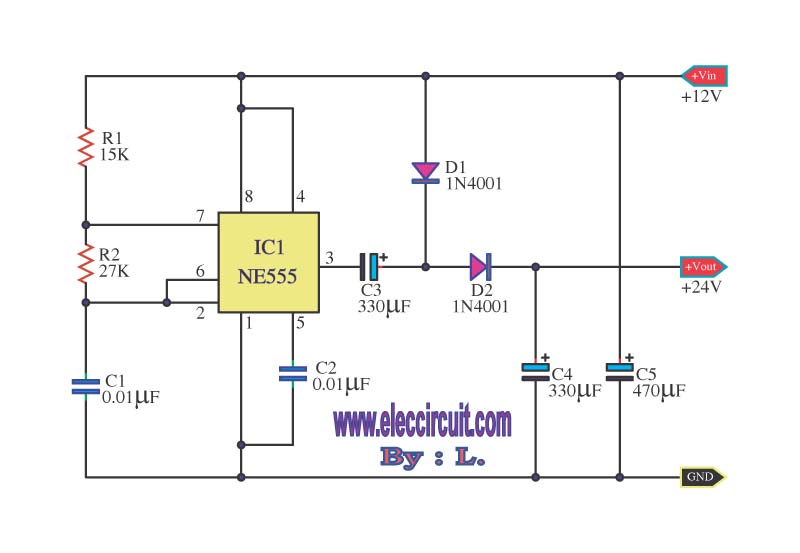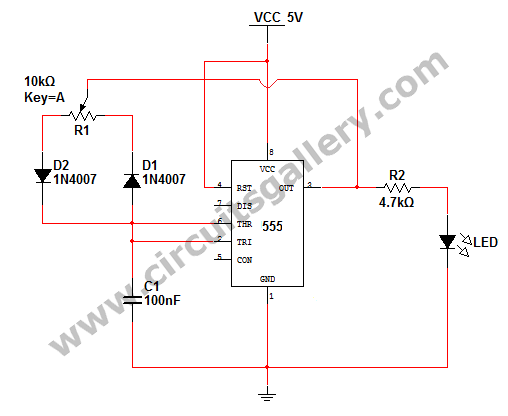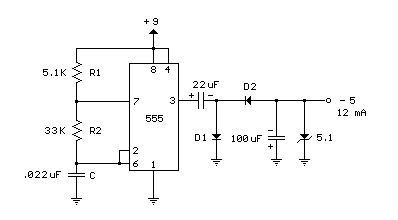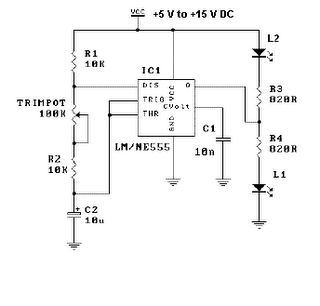
555 mark space
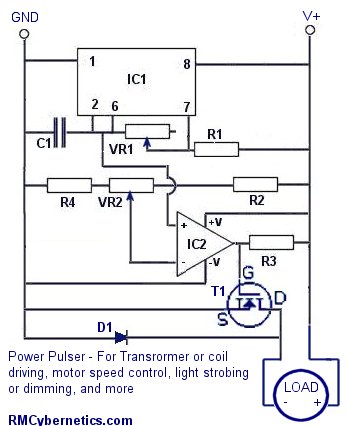
On astable multivibrators, the duty cycle is typically fixed unless a potentiometer is incorporated. However, even with a diode in parallel with resistor R2, the duty cycle will only be less than 50%. To initiate a new thread, one can click here. The author has been involved in electronics for approximately two years and notes that other forum participants are more knowledgeable. It is necessary to insert a diode in parallel with RB, with the cathode directed towards the timing capacitor. An additional diode, while not essential, is beneficial when placed in series with RB, with the cathode positioned away from the timing capacitor. This configuration allows the charge path to include RA, flowing through the parallel diode into the capacitor C. The discharge occurs through the series diode and RB to the discharge transistor. This arrangement enables a duty cycle range from less than 5% to greater than 95%. For reliable operation, a minimum resistance value of 3kΩ for RB is recommended to ensure oscillation initiation. This circuit design is quite common. A circuit without a diode, utilizing the output at pin 3, is prone to frequency and duty cycle variations with changes in voltage. Although this simpler configuration lacks a diode, it is generally avoided due to its inferior stability.
In an astable multivibrator configuration, the circuit operates continuously between its high and low states, generating a square wave output. The duty cycle, which defines the proportion of time the output is high compared to the total cycle time, is a critical parameter in applications such as pulse width modulation (PWM) and timing circuits. The addition of a potentiometer can allow for adjustments in the duty cycle, but the presence of a diode in parallel with resistor R2 limits the duty cycle to below 50%.
Incorporating a diode in parallel with resistor RB, with the cathode connected towards the timing capacitor, enhances the charging path of the capacitor. This design ensures that during the charging phase, current flows through resistor RA and the parallel diode, allowing the capacitor to charge more effectively. The inclusion of a second diode in series with RB, oriented with the cathode away from the timing capacitor, facilitates the discharge of the capacitor through RB and the discharge transistor. This dual-diode configuration broadens the operational duty cycle range significantly, permitting values from less than 5% to over 95%.
For optimal performance, it is crucial to select a minimum resistance value of 3kΩ for RB, which is essential to initiate oscillations reliably. In contrast, a simpler astable multivibrator circuit that omits the diode and utilizes the output at pin 3 tends to exhibit instability, as it is sensitive to variations in supply voltage, affecting both frequency and duty cycle. Therefore, while the simpler circuit may be appealing for its reduced component count, the enhanced stability and performance of the diode-inclusive design make it preferable for most applications.On astable multivibrators, the duty cycle is usually fixed unless there`s a potentiometer in place, but even still with a diode in parallel with R2, you will only get a duty cycle less than 50%. Also, to ask a question in a new thread, youcan click here. I`ve only been dealing with electronics for about 2 years now. The other people on this forum are much more helpful. it becomes necessary to insert a diode in parallel with RB, cathode toward the timing capacitor. Another diode is desirable, but not mandatory (this one in series with RB), cathode away from the timing capacitor. Now the charge path becomes RA, through the parallel diode into C. Discharge is through the series diode and RB to the discharge transistor. This scheme will afford a duty cycle range from less than 5% to greater than 95%. It should be noted that for reliable operation a minimum value of 3kW for RB is recommended to assure that oscillation begins.
That circuit is quite common. The circuit without a diode, but using the output at pin 3 is susceptible to changes in frequency and duty cycle with changes in voltage. It is a tiny bit simpler circuit than the conventional circuit with a diode, but I prefer not to use it because of its poor stability.
🔗 External reference
In an astable multivibrator configuration, the circuit operates continuously between its high and low states, generating a square wave output. The duty cycle, which defines the proportion of time the output is high compared to the total cycle time, is a critical parameter in applications such as pulse width modulation (PWM) and timing circuits. The addition of a potentiometer can allow for adjustments in the duty cycle, but the presence of a diode in parallel with resistor R2 limits the duty cycle to below 50%.
Incorporating a diode in parallel with resistor RB, with the cathode connected towards the timing capacitor, enhances the charging path of the capacitor. This design ensures that during the charging phase, current flows through resistor RA and the parallel diode, allowing the capacitor to charge more effectively. The inclusion of a second diode in series with RB, oriented with the cathode away from the timing capacitor, facilitates the discharge of the capacitor through RB and the discharge transistor. This dual-diode configuration broadens the operational duty cycle range significantly, permitting values from less than 5% to over 95%.
For optimal performance, it is crucial to select a minimum resistance value of 3kΩ for RB, which is essential to initiate oscillations reliably. In contrast, a simpler astable multivibrator circuit that omits the diode and utilizes the output at pin 3 tends to exhibit instability, as it is sensitive to variations in supply voltage, affecting both frequency and duty cycle. Therefore, while the simpler circuit may be appealing for its reduced component count, the enhanced stability and performance of the diode-inclusive design make it preferable for most applications.On astable multivibrators, the duty cycle is usually fixed unless there`s a potentiometer in place, but even still with a diode in parallel with R2, you will only get a duty cycle less than 50%. Also, to ask a question in a new thread, youcan click here. I`ve only been dealing with electronics for about 2 years now. The other people on this forum are much more helpful. it becomes necessary to insert a diode in parallel with RB, cathode toward the timing capacitor. Another diode is desirable, but not mandatory (this one in series with RB), cathode away from the timing capacitor. Now the charge path becomes RA, through the parallel diode into C. Discharge is through the series diode and RB to the discharge transistor. This scheme will afford a duty cycle range from less than 5% to greater than 95%. It should be noted that for reliable operation a minimum value of 3kW for RB is recommended to assure that oscillation begins.
That circuit is quite common. The circuit without a diode, but using the output at pin 3 is susceptible to changes in frequency and duty cycle with changes in voltage. It is a tiny bit simpler circuit than the conventional circuit with a diode, but I prefer not to use it because of its poor stability.
🔗 External reference

